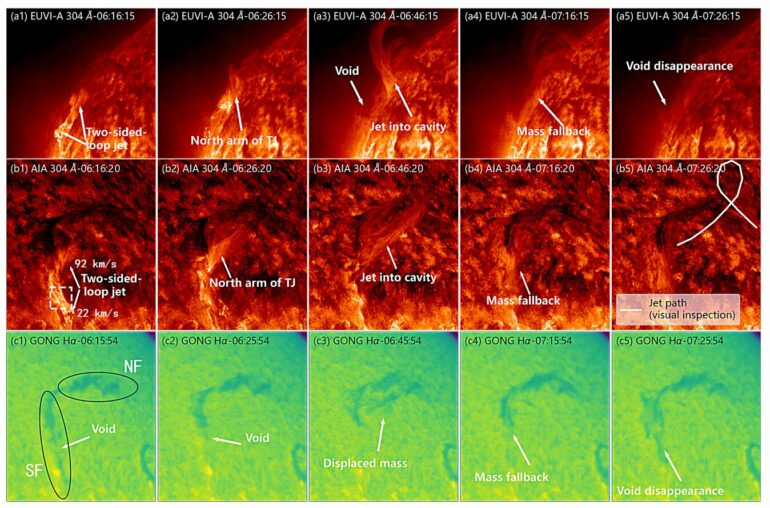Researchers led by Prof. Shen Yuandeng and his student Tan Song from the Yunnan Observatories of the Chinese Academy of Sciences (CAS) have discovered new form of oscillation in a single filament driven by a two-sided-loop jet.
The study was published in Monthly Notices of the Royal Astronomical Society.
Filaments are composed of cold plasma material suspended in the solar atmosphere and appear as dark absorbing structures, whose magnetic information is crucial to our understanding of the formation, stability and eruption of filaments.
In their previous study, Tan Song et al explored jet-filament interactions by means of the motion of a two-sided-loop jet in the magnetic rope structure of a filament-coronal cavity.
In the current study, they turned their attention to the large-amplitude filament oscillation triggered by two-sided-loop jet and analyzed the nature of this large-amplitude oscillation with the help of joint observations from the Solar Dynamics Observatory (SDO), Solar Terrestrial Relations Observatory (STEREO) and Global Solar Oscillation Detection Network (GONG).
The researchers studied the oscillations of a large filament on Nov. 29, 2011. They found that the two-sided-loop jet generated at the southern foot of the filament first moved northwards along the magnetic lines that formed the coronal cavity, and then pushed a part of the filament material up and back down before starting to oscillated longitudinally at the bottom of the coronal cavity (magnetic dips).
At the same time, the northern part of the filament began to oscillate transversely. The amplitude and period of the longitudinal (transverse) oscillations were 12.96 (2.99) Mm and 1.18 (0.33) h, respectively.
The radius of curvature at the base of the magnetic dips was obtained by the seismology method to be about 151 Mm, which was in good agreement with the innovative three-dimensional reconstruction of the directly “seen” magnetic depressions (166 Mm).
The magnetic field strengths of the northern and southern parts of the filament were also diagnosed at 23 and 21 Gauss, respectively, which also diagnosed the lower limit of the jet energy.
The researchers suggested that the newly formed jets could not only trigger simultaneous longitudinal and lateral oscillations in a single filament, but also be used as a seismological tool to diagnose information about the filaments (e.g., magnetic structure, magnetic field strength and magnetic twists).
More information:
Song Tan et al, Stereoscopic observation of simultaneous longitudinal and transverse oscillations in a single filament driven by two-sided-loop jet, Monthly Notices of the Royal Astronomical Society (2023). DOI: 10.1093/mnras/stad295. On arXiv: DOI: 10.48550/arXiv.2301.07989
Provided by
Chinese Academy of Sciences
Citation:
Scientists discover new form of oscillations in single filament driven by two-sided-loop jet (2023, February 22)



